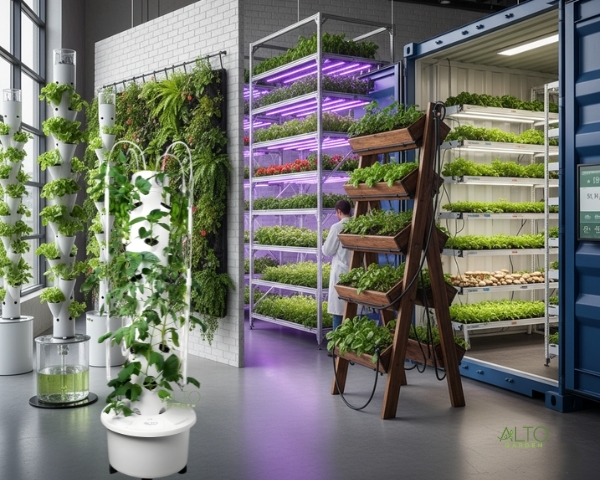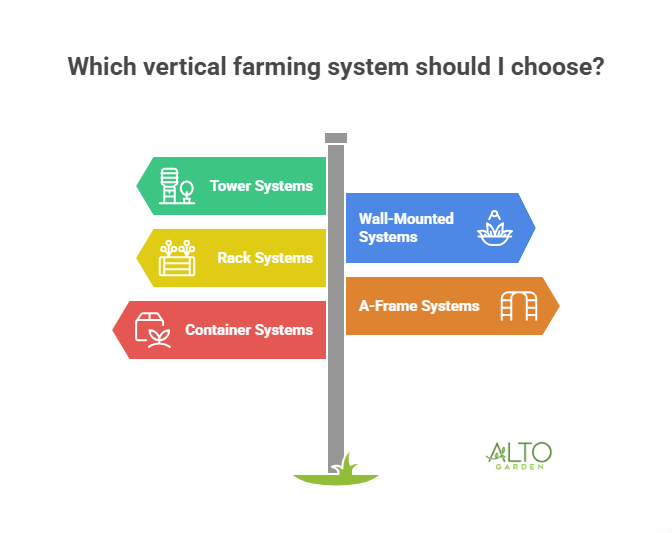Jan 23rd 2025
Vertical Farming at Home: Your Path to Fresh, Local Produce
These days, growing veggies, berries, or greens inside is simpler than ever before. Regardless of the weather, you can have fresh vegetables at home year-round by establishing a hydroponic or aeroponic vertical farming system right in your living space. You can run a successful vertical garden without any prior farming expertise, especially with the help of modern hydroponic GX tower systems designed for easy home use.

What is Vertical Farming?
Using the most recent agrotechnical techniques, vertical farming is an innovative way of growing food plants indoors using stacked layers or towers. Through the use of vertical space, farms can be situated in cities and towns and offer year-round fresh vegetables, berries, greens, and herbs.
Because plants are cultivated in a perfectly regulated environment, vertical farms ensure efficient use of land and space, don’t emit carbon dioxide, and don’t require pesticides. Furthermore, compared to conventional greenhouses, hydroponics vertical farming uses up to 95% less water, making it both eco-friendly and space-saving.
In recent years, vertical farming has become increasingly popular. The FoodTech Data Navigator reports that 341 startups are engaged in vertical farming. The United States presently leads the world market for vertical farming, but other nations with little territory, like Singapore, or harsh climates, like the Middle East, might see quick expansion.
Types of Vertical Farming Systems
Vertical farming systems come in several designs - each created for specific environments and goals. Some are visually appealing for home or display setups, while others focus on efficiency and production.
Tower Systems
Hydroponic towers are among the most efficient and low-maintenance systems. Nutrient-rich water is pumped to the top of the tower, trickling down over the roots before returning to the reservoir. This closed-loop design saves water and nutrients, making it perfect for beginners who want high yields with minimal effort. If you’re new to vertical gardening, a hydroponic tower is a great way to start.
Wall-Mounted Systems
Wall-mounted systems combine functionality and aesthetics, allowing you to turn blank walls into vibrant green displays. These systems can range from a single row of plants to full wall installations. Water and nutrients drip from the top down, feeding the plants along the way. While beautiful and space-saving, they do require careful setup to prevent leaks or downward stem growth.
Rack Systems
Rack systems are ideal for indoor farms in warehouses or basements. Plants grow on multiple racks stacked vertically, often under LED grow lights that mimic sunlight. This design works well for hydroponic or aeroponic setups, offering full control over the growing environment. Energy-efficient LED lighting ensures that every plant receives the perfect light spectrum for healthy growth.
A-frame Systems
An A-frame system uses an A-shaped structure to hold several tiers of plants. Typically made from metal, wood, or plastic, these systems are highly durable and often include built-in irrigation. They’re especially popular with commercial growers due to their stability and scalability, but they also work well for serious home gardeners.
Container System
In container farming, plants are grown inside modified shipping containers equipped with lighting, irrigation, and climate control. This approach is fully modular and allows you to grow crops anywhere - even in areas with harsh climates or limited space. Container systems are ideal for those who want maximum control over temperature, humidity, and light.

How to Start Vertical Gardening at Home?
What are the steps involved in starting a vertical farm at home? A few things need to be taken into account before you begin purchasing equipment for your new grow structure.
- The size of the system and the kinds of crops you plan to grow will depend on the amount of space you have available. In general, home vertical farms don’t require a lot of room. However, you should still think carefully about where your system will be placed - whether indoors or outdoors.
- Any location that has adequate floor space and height to support the structure can be used to establish a vertical farm. You might use a sunny corner of a room, an unused cabinet, or even a grow tent. Just make sure your chosen spot has easy access to power and water for lighting and irrigation.
- Depending on your preferences, you can cultivate nearly any kind of crop in your vertical garden. Many people start with fast-growing greens like lettuce or spinach, but you can also grow herbs, berries, or even small vegetables. You can begin with seedlings or cuttings, or start entirely from seeds - whichever suits your experience level and goals best.
- There are many types of vertical structures you can choose from, including shelves, racks, towers, barrels, walls, and stacked containers. If you plan to grow indoors, consider adding a proper lighting arrangement. LED grow lights are especially popular for vertical gardening since they’re energy-efficient, long-lasting, and provide the ideal spectrum for plant growth.
- Nutrients are an essential part of any home hydroponic or aeroponic setup. Fertilizers and growth promoters help your plants flourish, producing stronger, healthier, and more flavorful yields. The exact type of nutrients you’ll need depends on the crop, but for most home systems, a simple two-part A+B nutrient solution works very well and is easy to maintain.
- Plants grow best when conditions stay stable. Keep the temperature between 65–75°F (18–24°C) and humidity around 50–70%. If you live in an area with extreme climates, small fans or dehumidifiers can help maintain ideal conditions inside your setup.
- Check your system daily for water levels, light intensity, and nutrient balance. Clean pumps, filters, and tubing regularly to prevent clogs or algae growth. Trimming dead leaves or overgrown roots helps your system run efficiently and keeps plants healthy.
- Once your greens are mature, simply harvest and enjoy! Vertical farming allows continuous planting, so after one harvest, you can start another batch immediately. Over time, you’ll learn which crops thrive best in your specific setup and environment.
Ready To Grow Your Own Food At Home?
Explore our hydroponic tower systems - designed for simplicity, efficiency, and amazing harvests right in your living space. Your fresh greens are just a few weeks away.
Shop NowVertical Farming at Home Costs
The price of vertical farming at home is mostly determined by your demands, objectives, and financial situation. Additionally, the price will change according to whether you want to undertake vertical farming indoors or outside. For $200 - $300, you can get an entry-level setup for vertical farming at home. As with most things however - you get what you pay for. High-end setups with better quality components (such as pumps, lights, UV-resistant food-grade material) can definitely run up to $1,000 or more. But with regular maintenance these systems can endure for many years providing bountiful harvests during that time.
FAQs
- Can I grow all types of vegetables in a vertical garden?
While most leafy greens, herbs, and small fruits thrive in home vertical systems, larger plants like squash or corn may not be ideal. Hydroponic and aeroponic towers are perfect for high-yield, fast-growing crops that fit smaller spaces such as kitchens, balconies, or closets. - Do I need special knowledge to maintain a vertical farming system?
Not at all. Modern hydroponic systems are designed for beginners. With basic guidance on nutrient solutions, water management, and lighting, you can maintain your vertical farm easily. Many kits come with step-by-step instructions or support from suppliers to ensure success. - What are the benefits of vertical gardening?
Vertical gardening saves space, reduces water use by up to 95%, and allows year-round growing. It’s perfect for apartments or homes with limited outdoor space and delivers fresh produce anytime. - How does hydroponics vertical farming work?
In hydroponics vertical farming, plants grow without soil. Instead, nutrient-rich water circulates through the system, feeding plant roots directly for faster, cleaner, and more sustainable growth.




